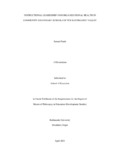
Please use this identifier to cite or link to this item:
https://hdl.handle.net/20.500.14301/304| Title: | INSTRUCTIONAL LEADERSHIP AND ORGANIZATIONAL HEALTH IN COMMUNITY SECONDARY SCHOOLS OF THE KATHMANDU VALLEY |
| Authors: | Pande, Suman |
| Citation: | Pande, S.(2021).Instructional Leadership and Organizational Health in Community Secondary Schools of the Kathmandu Valley |
| Issue Date: | Apr-2021 |
| School: | SOED |
| Department: | DODE |
| Level: | M.Phil. |
| Program: | MPhil in Development Studies |
| Abstract: | Instructional Leadersip (IL) is the leadership role of head teacher especially focused on developing teaching and learning at school and Organizational Health (OH) is about how well the school members function together to operate the school activities effectively. The IL and OH status of the school, the two important factors of the school effectiveness play a crucial role in the academic achievement of the school. Therefore, the study aimed at identifying the factors of IL and OH of community secondary schools suitable in the local context of Nepal; to measure the level of IL and OH of these schools; and to find out how the school’s OH is affected by IL in these schools. For this, a survey research was designed and questionnaire was prepared by conducting classical Delphi process on the original IL model of Hallinger and Murphy (1985) and OH model of Hoy et al. (1991). The reliability of the questionnaire was tested by piloting the questionnaire with 30 head teachers and teachers. The respondents included head teacher and one teacher from 172 community secondary schools out of total 303 community secondary schools selected randomly for the study from the Kathmandu valley. Factor analysis was employed to 6 identify suitable factors of IL and OH of school. Mean scores of these factors were used to measure the level of IL and OH of school. Then multiple regression analysis was done to find out the strength of different factors of IL and OH of school. Factor analysis retained 3 factors with 25 items for IL and 3 factors with 14 items for OH of school. The factors retained for IL were 1) planning, managing and supervising instructional program; 2) motivating and developing competence of teachers and students and 3) involving parents. Likewise, the factors retained for OH of school were 1) morale and resource management at school; 2) head teacher’s right, power and influence at school and 3) outside pressure at school. The study showed that the school head teachers performed the IL roles of involving parents at the first level; planning, managing, and supervising instructional program at the second level, and motivating and developing competence of teachers and students at the third level. Likewise, among the factors of OH of school, morale and resource management ranked at the first level; head teacher’s right, power and influence at the second level and outside pressure at school was almost negligible representing at the third level. The result of multiple regression analysis revealed that the IL factors are the significant predictors for two factors of OH of school (i) morale and resource management at school and (ii) head teacher’s right, power and influence at school but instructionsl leadership factors remained statistically insignificant for the factor (iii) outside pressure at school. It is thought that this study of IL and OH of school in which the factors of IL and OH of school are developed may help in knowledge contribution in the field of IL and OH of school in the context of Nepal. |
| URI: | https://hdl.handle.net/20.500.14301/304 |
| Appears in Collections: | Dissertations |
Files in This Item:
| File | Description | Size | Format | |
|---|---|---|---|---|
| Suman Pandey Super Finally Edited 19 May Language Edited Final Suman 19_PA_ED (1).pdf | 1.32 MB | Adobe PDF |  View/Open |
Items in DSpace are protected by copyright, with all rights reserved, unless otherwise indicated.